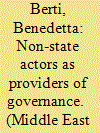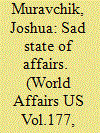|
|
|
Sort Order |
|
|
|
Items / Page
|
|
|
|
|
|
|
| Srl | Item |
| 1 |
ID:
136629


|
|
|
|
|
| Summary/Abstract |
The latest war in Gaza—from the beginning of July to the end of August 2014—is over, but both Israelis and Palestinians believe it will not be the last one. Israelis believe they must deter Hamas from conducting additional attacks and keep it weak should a conflict occur. This is an approach that more pro-Western Palestinian leaders and Arab states like Saudi Arabia, fearing the political threat Hamas poses, often quietly applaud. For their part, Hamas leaders remain hostile to Israel and feel politically trapped by the extensive blockade of Gaza—and all the while, Gaza lies in ruins. The combination is explosive. Israeli security analyst Yossi Alpher put it succinctly: “It is increasingly clear that the Gaza war that ended in August will soon produce…another Gaza war.”1 The Economist also gloomily predicted that “war will probably begin all over again, sooner or later.”2
|
|
|
|
|
|
|
|
|
|
|
|
|
|
|
|
| 2 |
ID:
134578


|
|
|
|
|
| Summary/Abstract |
With the latest round of Israel-Hamas hostilities giving way to a tense truce and cease-fire negotiations in Cairo, the Palestinian national-unity agreement has suddenly, and unexpectedly, become central to the thinking of all major players. What had looked strongly like a pro forma and essentially failed political initiative may be salvaged and transformed by the Gaza war into a centerpiece of the post conflict scenario. It will not, in reality and in the short term, involve full Palestinian political reunification. That would require a merging of the security and armed forces of the Palestinian Authority (PA) and Hamas and, in effect, the disarming of Hamas's paramilitary wing, the Qassam Brigades. There is no chance Hamas would agree to this unless the organization were truly broken, and nothing in the foreseeable future appears likely to achieve that result. However, a degree of Palestinian political transformation now appears possible.
|
|
|
|
|
|
|
|
|
|
|
|
|
|
|
|
| 3 |
ID:
136653


|
|
|
|
|
| Summary/Abstract |
The long conflict between Israel and Palestine took a turn for the worse after the kidnapping and killing of three Israeli teenagers in June 2014. The three teens—Naftali Fraenkel, Gilad Shaer and Eyal Yifrah—disappeared while in the West Bank, leading Israel to conduct a massive manhunt in the Palestinian territory, alleging that they were abducted by members of Hamas (a Sunni Islamist group in Palestine, recognised by many countries as a terrorist organisation).1 On July 2, 2014, a 16-year-old Palestinian named Muhammed Abu Khdeir was found dead in Jerusalem, leading to reports claiming that it was a revenge killing by Jewish extremists for the murders of the three Israeli boys.2 These events led to Israel launching ‘Operation Protective Edge’ in the Gaza Strip, which is primarily controlled by Hamas. Since the beginning of the operation on July 8, according to reports, 5,226 air strikes took place in Gaza and 4,591 rockets and mortars were fired at Israel. According to the Israeli Defence Forces (IDF), it attacked 5,263 targets across the Gaza Strip, hitting terror infrastructure, namely rocket launching sites, arms and munitions factories and warehouses, as well as the homes and offices of Hamas and its local regime. Over 34 known tunnels were also destroyed.3
|
|
|
|
|
|
|
|
|
|
|
|
|
|
|
|
| 4 |
ID:
136426


|
|
|
|
|
| Summary/Abstract |
The article tracks Hamas's political evolution by analyzing its governance record, as well as its political, economic, and social policies as the effective government in the Gaza Strip between 2007 and 2013. By providing a specific snapshot in time, the study focuses on understanding Hamas's approach to governance, as well as how the group has been able to function as a “rebel government” since taking over the Gaza Strip. The article also highlights the complex interactions between Hamas the political party, Hamas the effective government, and Hamas the non-state armed group.
|
|
|
|
|
|
|
|
|
|
|
|
|
|
|
|
| 5 |
ID:
136601


|
|
|
|
|
| Summary/Abstract |
In this overarching March 2014 inaugural lecture at the newly established Center for Palestine Studies at the University of London’s School of Oriental and African Studies (SOAS), Palestinian historian Walid Khalidi, while reminiscing about the genesis and evolution of the new narrative on the 1948 war, provides fresh analyses of both the Balfour Declaration and UN Security Council Resolution 242. He also addresses such pressing Palestinian issues as the one-state/twostate debate, Boycott, Divestment and Sanctions (BDS), and the Hamas/Fatah relationship. He concludes by highlighting the potentially catastrophic nature of the disputes centering on Jerusalem’s Muslim holy places and the threat to the Middle East posed by the policies of Benjamin Netanyahu, “the most dangerous political leader in the world today.”
|
|
|
|
|
|
|
|
|
|
|
|
|
|
|
|
| 6 |
ID:
134250


|
|
|
|
|
| Summary/Abstract |
This article analyses the evolving uses of social media during wartime through the IDF (Israel Defense Forces) Spokesperson Facebook and Twitter accounts. The conflict between Israel and Hamas-affiliated groups in November 2012 has generated interesting data about social media use by a sovereign power in wartime and the resultant networked discourse. Facebook data is examined for effective patterns of dissemination through both content analysis and discourse analysis. Twitter data is explored through connected concept analysis to map the construction of meaning in social media texts shared by the IDF. The systematic examination of this social media data allows the authors’ analysis to comment on the evolving modes, methods and expectations for state public diplomacy, propaganda and transparency during wartime.
|
|
|
|
|
|
|
|
|
|
|
|
|
|
|
|
| 7 |
ID:
134841


|
|
|
|
|
| Summary/Abstract |
The Gaza war of July and August 2014 occasioned the sharpest frictions in memory between the United States and Israel, highlighted by a cease-fire proposal offered by Secretary of State John Kerry that Israel’s security cabinet rejected unanimously. Kerry’s plan envisioned a seven-day cease-fire, during which the parties would negotiate “arrangements” to meet each of Hamas’s demands about the free flow of people and goods into Gaza and the payment of salaries of Hamas’s tens of thousands of employees. As for Israel’s demands about destruction of tunnels and rockets and the demilitarization of Gaza, these were not mentioned at all, except in the add-on phrase that the talks would also “address all security issues.”
|
|
|
|
|
|
|
|
|
|
|
|
|
|
|
|
| 8 |
ID:
137025


|
|
|
|
|
| Summary/Abstract |
Many of the world’s most infamous terrorist organizations demonstrate clear political aptitude, maintaining highly successful political parties while simultaneously carrying out terrorist attacks. Yet the relationship between terrorism and a group’s political fortune is unclear. Groups like Hamas and Hezbollah appear to have gained significant support as a consequence of certain attacks, most notably those against US and Israeli targets. Other organizations fight for their political life after certain attacks. The Provisional Irish Republican Army (IRA) and its political wing, Sinn Fein, scrambled to restore its public image after bombs in Enniskillen, Northern Ireland, killed 11 Protestant civilians. In this article I examine the relationship between violence and political participation. I show that rebel groups are less likely to attack civilians when they simultaneously participate in democratic elections. I argue that attacking civilians is not good for political business. Not only can it distinguish the group as a terrorist organization and alienate supporters as a result, but attacking civilians also imposes high costs on the group’s own civilian support base. For these reasons, civilians frequently withdraw political support for rebel groups after they target civilians, which can be profoundly harmful to rebels. I analyze the violent and political behavior of non-state violent organizations from the Middle East and North Africa from 1980 to 2004. I also examine the IRA as a means of describing the causal mechanism advanced here.
|
|
|
|
|
|
|
|
|
|
|
|
|
|
|
|
|
|
|
|
|